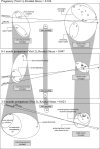Capturing Changes in HIV-Infected Breastfeeding Mothers' Cognitive Processes from Before Delivery to 5 Months Postpartum: An Application of the Pile-Sorting Technique in Haiti
- PMID: 29955729
- PMCID: PMC6007337
- DOI: 10.1093/cdn/nzy017
Capturing Changes in HIV-Infected Breastfeeding Mothers' Cognitive Processes from Before Delivery to 5 Months Postpartum: An Application of the Pile-Sorting Technique in Haiti
Abstract
Background: The cognitive processes involved in individuals' perceptions and prioritization of information, and how these change with experience or exposure to interventions, are rarely examined in the evaluation of nutrition interventions. Exclusive breastfeeding counseling is a common infant and young-child feeding intervention and is used to promote HIV-free survival in the prevention of mother-to-child transmission programs. However, it is often designed without adequate attention to the changes in mothers' perceptions over the course of their early breastfeeding experiences.
Objective: The aim of this study was to identify HIV-infected breastfeeding mothers' cognitive structure (their organization of messages and ideas) of infant feeding messages and to characterize whether their cognitive organization of infant feeding messages changed from pregnancy through the first 5 mo postpartum.
Methods: With the use of semistructured interviews and the cognitive mapping technique of pile sorting, we interviewed 30 HIV-infected breastfeeding mothers in Port-au-Prince, Haiti. We asked them to sort and rate 18 infant feeding messages 3 times (during pregnancy, 0- to 1-mo postpartum, and 3- to 5-mo postpartum). We analyzed their responses by using multidimensional scaling, property fitting, and partition analyses.
Results: At all 3 visits, we found consistency in women's cognitive mapping of messages. For example, mothers consistently differentiated messages pertinent for exclusive breastfeeding compared with those that pertained to other practices. However, subtle variations in mothers' cognition over time were also evident, particularly at 0- to 1-mo postpartum, when message proximity was tightly clustered compared with the earlier and later periods.
Conclusions: We conclude that mothers share a common cognitive organization of infant feeding messages and that this organization changes over time. Attention to variations in cognition can support context-sensitive, patient-centered counseling by practitioners and improve the effectiveness of nutrition interventions. Pile sorting is an efficient, systematic technique to examine cognitive processes related to health and nutrition.
Keywords: HIV; Haiti; breastfeeding; cognitive mapping; infant and young child feeding; maternal perceptions; pile sorting; pregnant and lactating women.
Figures


Similar articles
-
Who knows what: An exploration of the infant feeding message environment and intracultural differences in Port-au-Prince, Haiti.Matern Child Nutr. 2018 Apr;14(2):e12537. doi: 10.1111/mcn.12537. Epub 2017 Oct 4. Matern Child Nutr. 2018. PMID: 28976068 Free PMC article.
-
Tailored text messages to improve breastfeeding practices in Yangon, Myanmar: the M528 individually randomized controlled trial.Am J Clin Nutr. 2023 Mar;117(3):518-528. doi: 10.1016/j.ajcnut.2023.01.003. Epub 2023 Jan 10. Am J Clin Nutr. 2023. PMID: 36811470 Clinical Trial.
-
Infant feeding by South African mothers living with HIV: implications for future training of health care workers and the need for consistent counseling.Int Breastfeed J. 2019 Feb 14;14:11. doi: 10.1186/s13006-019-0205-1. eCollection 2019. Int Breastfeed J. 2019. PMID: 30815026 Free PMC article.
-
[Breastfeeding in Africa: will positive trends be challenged by the AIDS epidemic?].Sante. 2002 Jan-Mar;12(1):64-72. Sante. 2002. PMID: 11943640 Review. French.
-
Nutrition: basis for healthy children and mothers in Bangladesh.J Health Popul Nutr. 2008 Sep;26(3):325-39. doi: 10.3329/jhpn.v26i3.1899. J Health Popul Nutr. 2008. PMID: 18831228 Free PMC article. Review.
References
-
- Larsen JS, Hall EO, Aagaard H. Shattered expectations: When mothers' confidence in breastfeeding is undermined—a metasynthesis. Scand J Caring Sci 2008;22(4):653–61. - PubMed
-
- Monterrosa EC, Pelto GH, Frongillo EA, Rasmussen KM. Constructing maternal knowledge frameworks: how mothers conceptualize complementary feeding. Appetite 2012;59(2):377–84. - PubMed
LinkOut - more resources
Full Text Sources
Other Literature Sources

